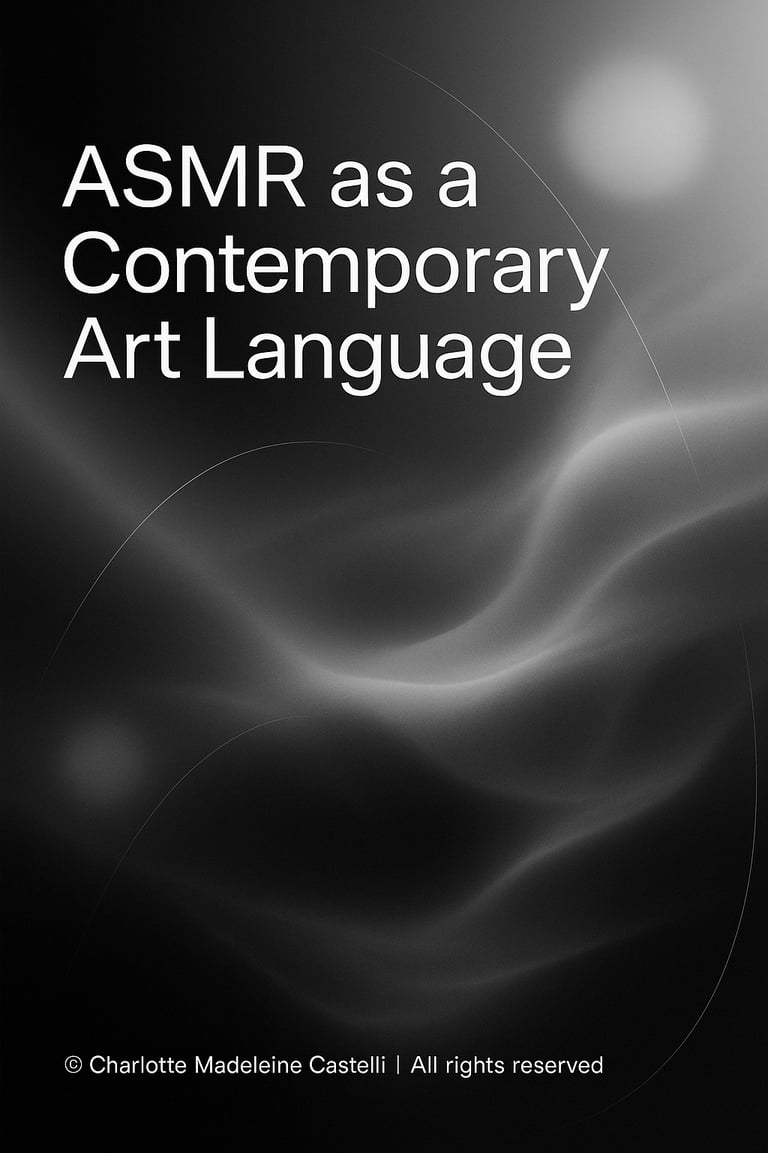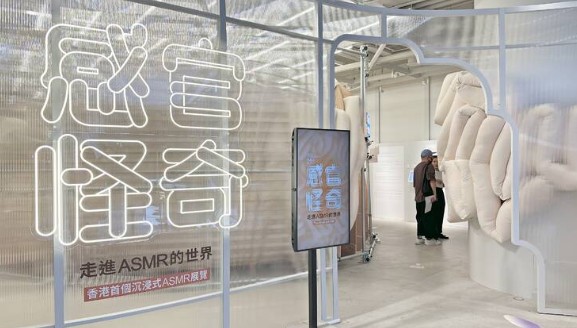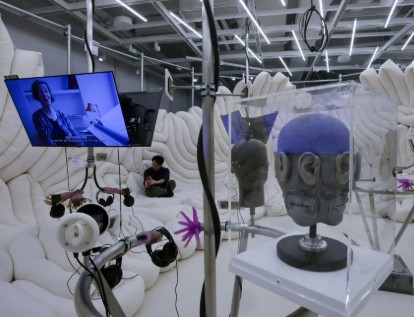Whispers Across the World: ASMR as a Contemporary Art Language
In Hong Kong’s futuristic AIRSIDE complex, Weird Sensation Feels Good redefines ASMR as a refined curatorial language—intimate, immersive, and conceptually potent. Beyond visual experience, the exhibition unfolds as a sonic architecture of care, where whispers, textures, and subtle vibrations become tools of introspection. Amidst the mirrored density of a global financial and cultural hub, ASMR emerges not as digital residue, but as a poetic act of resistance. A language for those who choose to feel, rather than merely observe. Future Maastricht may well be its next echo chamber.
INTERNATIONAL FAIRS & EXHIBITION
Charlotte Madeleine CASTELLI
6/26/20254 min read


I’ll admit it: I didn’t expect my next curatorial epiphany to come in the form of a whisper. And yet, there I was—in the mirrored verticality and hyperconnected hum of Hong Kong—suddenly suspended in a hush of texture and breath. Surrounded by soft clicks, gentle taps, and almost imperceptible murmurs within the dusky, tactile quiet of GATE33 Gallery, I understood something deeply elemental: the art of the future is not merely to be seen—it is to be felt, to be inhabited, to be heard




Set within AIRSIDE, Hong Kong’s newest cultural and architectural landmark built on the repurposed grounds of the former Kai Tak airport, the exhibition Weird Sensation Feels Good: The World of ASMR opened to the public on March 14, 2025. The venue itself carries symbolic weight—once a threshold to the world, now reborn as a site for sustainable design, speculative creativity, and future-facing narratives. But this is more than clever urban reuse. Hong Kong—long regarded as a global financial and technological nexus—is increasingly asserting its role as a site of cultural experimentation, where immersive aesthetics and hybrid curatorial practices flourish. With its reflective towers, high-velocity infrastructure, and suspended identity between East and West, it offers a living laboratory for rethinking how contemporary art reaches its audiences.
After acclaimed runs in Stockholm at ArkDes in 2020 and the Design Museum in London in 2022, the exhibition arrives in Asia with sharpened purpose. Under the guidance of curator and architect James Taylor-Foster, joined by Daisy Chu for the Hong Kong iteration, the exhibition repositions ASMR—a phenomenon born on YouTube and Reddit—as a legitimate cultural language. Their curatorial vision is to transform ASMR from a digital, intimate encounter into a shared physical and aesthetic experience, capable of evoking empathy, introspection, and collective resonance. As Taylor-Foster noted in a recent conversation, ASMR is one of the few truly global languages born from the internet. By bringing it into a museum space, we’re acknowledging the emotional and perceptual territory that online culture now occupies in our lives.
ASMR, or Autonomous Sensory Meridian Response, is best known for the gentle tingling sensation triggered by soft, rhythmic sounds—fabric rubbing, whispers, fingers tapping. But this exhibition moves far beyond sensation for its own sake. It uses ASMR as a conceptual material, a poetic infrastructure through which the human need for comfort, nearness, and intimacy is made audible. The more than forty works on view—from installations to videos and sonic sculptures—invite visitors to slow down, breathe deeply, and listen differently. The show is not about disengagement, but about a new form of focused presence.
Among the works, one encounters Tobias Bradford’s synthetic saliva mechanism, quietly dripping with disconcerting regularity, evoking a bodily fragility that is both clinical and intimate. Marc Teyssier’s hyperrealistic artificial skins ask to be touched, heightening the tension between synthetic surface and human response. A room devoted entirely to Bob Ross—the soft-spoken American painter whose televised brushstrokes calmed millions—is both homage and historical anchor, reminding us that the ASMR aesthetic precedes the term itself. These works don’t scream for attention; they whisper their way under the
Perhaps the most transporting space is the ASMR Arena, winner of the Dezeen
Exhibition Design Award. This one-kilometre-long cushioned tunnel becomes a chamber of sonic cloth, enveloping the body in a soundscape of subtle vibrations and ambient intimacy. Here, the visitor no longer spectates but drifts—wrapped in an acoustic membrane that reconnects them with their own sensory awareness. It is a place of softness with sharp intent.
What impressed me most was how intimately the exhibition converses with the city. Local artists AK Kan and Kin Lam reconstructed fragments of Hong Kong’s urban soundscape—the chimes of minibuses, the pulsation of MTR trains—allowing the public to engage with everyday objects and generate their own ASMR compositions. The city itself becomes a source of rhythm and resonance, grounding the exhibition in the textures of lived experience.
But more than a celebration of sensory novelty, this exhibition reveals a curatorial act of care. It proposes a deliberate slowing down, a radical tenderness, an acoustic empathy that lingers. Art, here, becomes a shared ritual of listening—to the world, to others, to ourselves. It is therapy not through explanation, but through affect. A collective archive of emotion assembled not in words, but in whispers.
Naturally, I began to wonder: what would it mean to bring this experience to Europe again—perhaps to the evolving spaces of Future Maastricht? Our venues, already immersed in narratives of urban regeneration, community design, and transdisciplinary dialogue, could offer fertile ground for a new iteration. One that blends the sensorial vocabulary of ASMR with the emerging fields of emotional AI, sound healing, and human-machine intimacy. A European edition could also explore themes around mental health, urban solitude, and the increasing estrangement from touch and attentiveness in a world of overstimulation. It would not be a simple exhibition, but a sensorial platform—a curatorial gesture toward reimagining the role of art as a site of transformation and embodied connection.
To choose to whisper, in a culture that is addicted to noise, is an act of resistance. And in that act, I believe Future—as a laboratory of speculative futures and poetic infrastructures—can and must be among the first to listen.
© Charlotte Madeleine Castelli | All rights reserved
